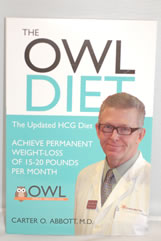 The HCG diet program has historically been broken down into three distinct phases, each with their own goal. Phase one is centered around loading or “gorging”, when a person takes in foods high in fat and low in carbs as they start the diet. This period lasts 2 to 3 days and is important for the protocol to function as intended. When you eat foods high in fat, while taking the HCG hormone, your fat cells enlarge and try to uptake more lipids. This actually enables the cells to burn off stored fat much more quickly once the diet phase begins in phase two. For the most part these phases of the diet are the same between the OWL approach and the original Dr. Simeons protocol, however, there are key differences in phase two and three of the method.
The HCG diet program has historically been broken down into three distinct phases, each with their own goal. Phase one is centered around loading or “gorging”, when a person takes in foods high in fat and low in carbs as they start the diet. This period lasts 2 to 3 days and is important for the protocol to function as intended. When you eat foods high in fat, while taking the HCG hormone, your fat cells enlarge and try to uptake more lipids. This actually enables the cells to burn off stored fat much more quickly once the diet phase begins in phase two. For the most part these phases of the diet are the same between the OWL approach and the original Dr. Simeons protocol, however, there are key differences in phase two and three of the method.
The original protocol was designed in the 1950s after some research which Dr. Simeons originally conducted on his patients. He found that people who were taking HCG not only had much reduced appetites, but could cut calories and still maintain a strong metabolism. As a result, many HCG users were able to lose weight far more quickly than was otherwise possible. Over the years it’s adapted and changed, but until recently everyone was still on his original 500 calorie per day protocol. Using many modern techniques, new research has been conducted over the last decade to see if this really is the best way to lose weight with the HCG diet. After a lot of studies and trials, it was found that certain limitations in the original protocol were not necessary for good ultimate results. Beyond that, many things Dr. Simeons originally disallowed, such as broccoli or carrots, are actually quite good for people as part of this type of weight loss.
What’s Different About the Modern OWL Approach?
Many people are now using a higher calorie approach for phase 2 that allows for considerable more leeway when it comes to what foods you can eat. Traditionally most vegetables and fruits were not permitted in phase two of the protocol. However, on the OWL approach people can eat most vegetables, so long as they are low starch and carbs. This includes almost everything from celery, to cabbage, to carrots and broccoli. Most of these were not permitted on the original protocol, but over the years, have been found to help people increase their metabolism naturally. There’s no downside to these vegetables so they’re now permitted. Also the diet increases from 500 calories per day to 700 calories per day, and variety in foods is encouraged. Rather than eating much the same meal each day, on the modern approach people should change up the foods they eat to help their metabolism get going.
On the OWL approach you can also increase the time you’re on the diet from around 43 days, at the maximum originally, to 60 days. There are many reasons for this, as the diet is designed for long term use. Because your diet is changing more often, and you’re having more calories, you’re typically going to be more healthy using this method than the original protocol. Beyond that, your body does not adapt as quickly to the hormone you’re taking and won’t decrease your metabolism as much with a 500 calorie per day method. You’re also allowed to exercise on this approach, which is typically never allowed on the original method. It’s a lot easier for you, but also a lot better for longevity on the diet. This can help people lose weight even faster, as they can often achieve 30 to 40 pounds of fat loss within only a single extended regimen.
